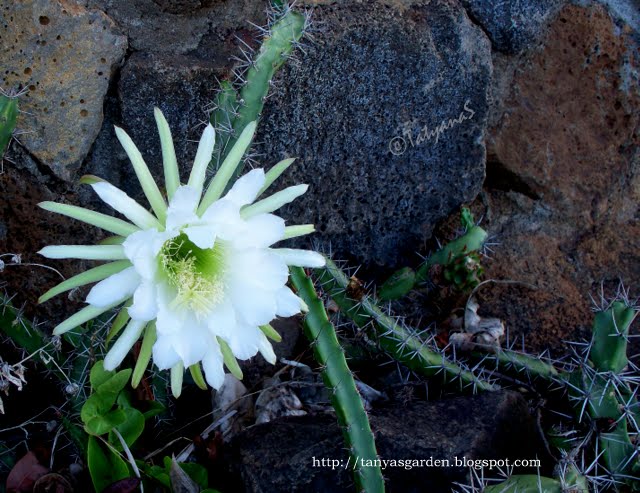If you have trees growing in containers, rotate them once in a while, my friends! I ignored this rule for several years, and sure enough, one of the Italian cypresses, in the background of the picture below, sent roots through the dranage hole in its pot*. By the way, I pruned those cypresses recently, and they look better now. It answers a question asked by one of the fellow bloggers - have I hired gardeners? In my dreams, Rene, in my dreams! (I have an earlier post Do You Have A Hired Gardener, Tatyana?)
this year. I should confess that I never had a plan of what to plant in this bed and what colors to use. I was just buying plants which I liked and which required full or part sun. Somehow, it worked well with pink and purples prevailing in July and August.
Acanthus mollis (Bear's Breech) didn't bloom last year. It just took a leave of absence I guess to gather energy, and voila - here it is showing its big glossy leaves and white flowers with purple markings:
Acanthus mollis (Bear's Breech) didn't bloom last year. It just took a leave of absence I guess to gather energy, and voila - here it is showing its big glossy leaves and white flowers with purple markings:
Well-drained soil, part shade - Acanthus has what it needs for long blooming in this location.
New students in the classrom were the drumstick alliums of rich, intense purple. I planted a lot of alliums last fall and winter. The drumsticks got the space in the central bed. Their green tops poked out in the past winter which was pretty mild. For half a year, I was skeptically watching the tall, thin, sickly looking green stems. What good could they produce? So, when these textured pom-poms greeted me in July, after our 11-day Alaskan vacation, I got pleasantly surprised. Yes, they were small, but I find their heads charming and interesting. It looks like they are floating above the other plants.
.
Die-hard Spanish lavender looks faded after almost a 3-month blooming period but still provides some color. Soon, I will lightly trim it to give it some shape and tidiness, but in January 2/3 of its green branches will be cut off (be sure to leave 1/3 of the GREEN branch. Nothing will grow from the leafless part of it).
.
Hardy fuschias never disappoint me. I bought them several years ago as tiny starter plants for $2.50 each, and since then they proved to be low-maintainance, reliable fellows. I remember my Mom used to have them as house plants. Geraniums, fuchsias, kalachoe, miniature roses were thriving indoors in the houses heated back then by stoves which didn't dry the air as central heating does now.
.
.
Daisies, a short compact variety, came here by chance when I was looking for a space to put clumps of them which I got after separating an original plant. They might look out of place in this picture, but there are three groups of these daisies blooming in front of the house, thus creating repetition (two of them are seen in the next picture). I would say that this summer was very good for daisies! Both varieties, short and tall, did their best!
.
*
The rose Mister Lincoln also came here not because of some great creative idea that struck me a couple years ago, but because I didn't find another place for the plant which was a gift from my mother-in-law. I wrote earlier about another rose which I planted in the vegetable/perennial bed for the same reason. I need to clarify that it's not actually a lack of space. There is a lawn that can always be reduced. What stops me, is the difficulty of preparing a planting hole for the roses. It takes several hours of digging, using a pick-axe, and picking out a great number of rocks of all sizes. It's much easier to put roses in already existing flowerbeds.
All my Mr.Lincoln roses, planted here and there, produced huge blooms this season. Probably, this is their response to a dose of composted horse manure which I spread under each bush in the spring.
Spurge (Euphorbia X martini), seen in several pictures above, has already been blooming for a couple of months. I can't say I love its color in this particular place, but what to do.
Previous posts about this flowerbed are here:
Front Flower Bed Summer Transformation
Front Garden Bed. Spring 2010
Front Flower Bed Summer Transformation
Front Garden Bed. Spring 2010
It's funny, I just noticed that I called this bed 'Flowerbed' and 'Garden bed'. What an inconsistency! I use the term 'Garden bed' to note the fact that, besides the flowering plants, there are shrubs and trees growing there:
Green Mound juniper, Sungold Threadbranch cypress,
dwarf English boxwood, Japanese maple, Canadale Gold euonymus and Privet tree (Ligustrum lucidum).
.
Green Mound juniper, Sungold Threadbranch cypress,
dwarf English boxwood, Japanese maple, Canadale Gold euonymus and Privet tree (Ligustrum lucidum).
.
*P.S. Lesson learned: After we cut that tall cypress' roots which escaped from its pot, we went on a short trip to Arizona. When we returned, the tree looked dull and its foliage was absolutely dry. I think, it's gone... It's clear to me now that the timing was wrong when we cut its roots: a heat wave came right after we left, and a neighbor didn't water it enough. This is a big loss for my garden. The remaining cypress needs to be relocated since the symmetry is now gone.
Copyright 2010 TatyanaS






